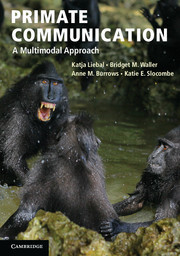Description
Primate Communication
A Multimodal Approach
Authors: Liebal Katja, Waller Bridget M., Burrows Anne M., Slocombe Katie E.
Multimodal approach to primate communication with focus on its cognitive foundations and how this relates to theories of language evolution.
Language: English
Subject for Primate Communication:
Approximative price 59.89 €
In Print (Delivery period: 14 days).
Add to cart
Primate Communication
Publication date: 11-2013
306 p. · 17.4x24.5 cm · Paperback
Publication date: 11-2013
306 p. · 17.4x24.5 cm · Paperback
Approximative price 82.21 €
In Print (Delivery period: 14 days).
Add to cart
Primate Communication
Publication date: 11-2013
304 p. · 17.8x25.3 cm · Hardback
Publication date: 11-2013
304 p. · 17.8x25.3 cm · Hardback
Description
/li>Contents
/li>Biography
/li>
Primates communicate with each other using a wide range of signals: olfactory signals to mark territories, screams to recruit help while fighting, gestures to request food and facial expressions to initiate play. Primate Communication brings together research on all forms of interchange and discusses what we know about primate communication via vocal, gestural, facial, olfactory and integrated multimodal signals in relation to a number of central topics. It explores the morphological, neural and cognitive foundations of primate communication through discussion of cutting-edge research. By considering signals from multiple modalities and taking a unified multimodal approach, the authors offer a uniquely holistic overview of primate communication, discussing what we know, what we don't know and what we may currently misunderstand about communication across these different forms. It is essential reading for researchers interested in primate behaviour, communication and cognition, as well as students of primatology, psychology, anthropology and cognitive sciences.
Foreword; Acknowledgements; Part I. Introduction to Primate Communication: 1. What is primate communication?; 2. The morphology of primate communication; 3. The neural substrates of primate communication; Part II. Approaches to Primate Communication: 4. The methods used in primate communication; 5. A multimodal approach to primate communication; Part III. Cognitive Characteristics of Primate Communication: 6. Acquisition; 7. Flexibility; 8. Intentionality; 9. Referentiality; Part IV. Approaches to the Evolution of Primate Communication: 10. A multimodal approach to the evolution of primate communication; Glossary; References; Appendix; Species index; Subject index.
Katja Liebal is Assistant Professor of Evolutionary Psychology at the Freie Universität Berlin, Berlin, Germany.
Bridget Waller is Senior Lecturer in the Department of Psychology and Acting Director of the Centre for Comparative and Evolutionary Psychology at the University of Portsmouth, Portsmouth, UK.
Katie Slocombe is Senior Lecturer in the Psychology Department at the University of York, York, UK and Scientific Director of the Budongo Trail Chimpanzee Exhibit at Edinburgh Zoo, Edinburgh, UK.
Anne Burrows is an Associate Professor at Duquesne University, Pittsburgh, PA, USA.
Bridget Waller is Senior Lecturer in the Department of Psychology and Acting Director of the Centre for Comparative and Evolutionary Psychology at the University of Portsmouth, Portsmouth, UK.
Katie Slocombe is Senior Lecturer in the Psychology Department at the University of York, York, UK and Scientific Director of the Budongo Trail Chimpanzee Exhibit at Edinburgh Zoo, Edinburgh, UK.
Anne Burrows is an Associate Professor at Duquesne University, Pittsburgh, PA, USA.
© 2024 LAVOISIER S.A.S.




